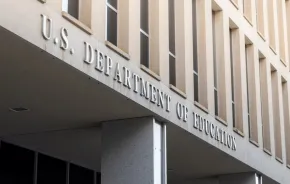
“It’s like what Mister Rogers did, but with neuroscience” is how I found myself describing the groundbreaking work David Lewis is doing for Seattle Public Schools (SPS). I wasn’t being glib — after all, any comparison to Mister Rogers is the highest form of praise. Lewis, who holds a doctorate in clinical psychology, is in his second year of serving as the director of Behavioral Health Services for Seattle Public Schools, a department that focuses on educational practices that align with social-emotional learning research and trauma-informed practices. What does that mean?

“Really, it’s just the melding of neuroscience and health,” explains Lewis. “If schools aren’t healthy or schools are anxiety-provoking, [the resulting] anxiety does damage in lots of various ways. And anxiety right now in our current day and age is much higher than it used to be.” If unaddressed, says Lewis, the anxiety can manifest as many of the same behaviors we see in ADHD and other behavioral disorders.
Lewis’ work comes at a crucial time for Seattle schools, as a booming economy and gentrification have exacerbated education inequities across the region. Students of color in the district have some of the largest achievement gaps in the country, and discipline policies in the district have faced substantial scrutiny.
Through years of research, Lewis has witnessed the power that schools have in shaping who children become. Building on this previous research, including work Lewis has done, Seattle Public Schools has implemented a multitiered system of support (MTSS), based on the idea that the needs of the whole child must be considered for a student to reach their greatest potential: academic, social, emotional and behavioral. Lewis uses his background to shape programs and policies in the district, including the Whole Child Whole Day (WCWD) project, a model that identifies environmental risk factors for many students, and then addresses them by putting protective factors in place. WCWD has been rolled out at 18 of Seattle’s 104 schools, with plans to increase the scale of the program this year.
“A child is developing 24 hours a day,” says Lewis. “And a child spends about 37 hours in a school context each week, and only around 15 hours outside of school during their waking hours. So much of a child’s development — socially, emotionally, their identity — is happening during the school day.”
How did you choose your career path and what keeps you going?
Growing up, I saw peers of mine who ended up doing really well in life, while others made decisions that ended in less than ideal circumstances — outcomes such as drug use, incarceration, etc. I grew to understand that those outcomes were indicative of the broader environments around them, including school. So much of the way a child sees themselves, and the world around them, is defined by school experiences. The hope is that their out-of-school experiences can also be productive and positive, which is where the Whole Child Whole Day project comes into play, focusing on school, home, community and a recommendation to find extracurricular or recreational activities for every kid to take part in. My dad died when I was 15, and because these environments around me were mostly positive, I ended up doing okay.
How does Whole Day Whole Child help schools ensure that they are creating a healthy environment for students?
[Providing] consistency and predictability is key. Through repetition, whether positive or negative, that’s going to become very intentional for how that child sees themselves, or the way they perform or behave. That can be a child who recognizes an emotion and regulates it well, or a kid who knocks the water bottle off the table when upset. It is critical that we help students form [emotional regulation] habits in early childhood, when most of these connections are being formed. If kids are dealing with other complexities, a healthy school environment with clear and predictable expectations — where kids feel supported and cared for — can lower that baseline stress so they are not sitting in that toxic stress zone.
How can this model help already overburdened schools deal with struggling students and discipline policies?
Unaddressed and chronic anxiety can lead to the wrong diagnoses when it comes to addressing and treating behavior problems, says Lewis. Chronic stress doesn’t just impact those students who are struggling academically or facing school discipline. It can also impact students who may be struggling with perfectionism.
If you aren’t addressing the right thing — through discipline, through an individualized education program, through the proper supports — a plan won’t work. If the plan doesn’t work, then you have these kids who are looking at themselves as not doing well, not smart enough, not good enough as time goes on, and those thoughts shape outcomes.
Lewis shares an anecdote about the two kinds of calls he has received at the district office.
You hear buzzwords like “safety issue,” and the conversation centers around moving that student out of his or her current school. Then there’s the calls where they discuss the challenges the student is facing, and ask, “Can you support us in keeping this child?” When I hear that, I know the outcome will be different. With the right supports — at home, at school — we can build that student up and put a plan in place to help them succeed.
What can parents do at home to help create an environment that aligns with the research you are doing?
Whether I am talking to a parent or a teacher, it comes down to high expectations and high support, consistency and predictability, and engagement styles that hold kids accountable but let kids know they are loved, cared about and supported. Tell your kids you love them every night before they go to bed. That’s the same world they wake up to. And if your student is struggling, work with your child’s school to help make a plan that works for everybody.
What’s the future of this program?
When the largest public school north of San Francisco adopts a new program, other districts get curious. My hope is that 10 years from now, these things I am naming with an acronym or with research — we might just call that school.











